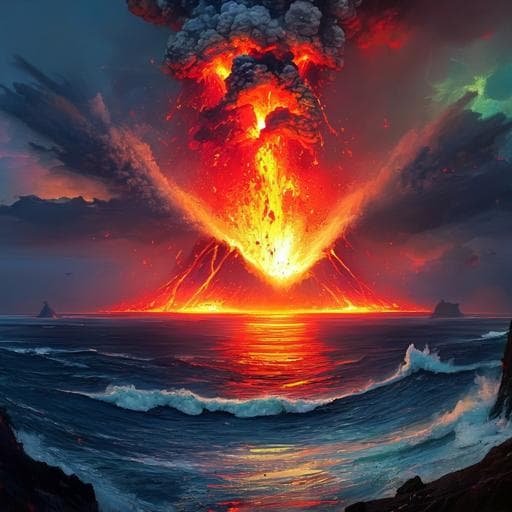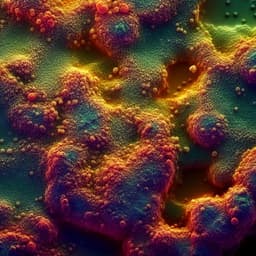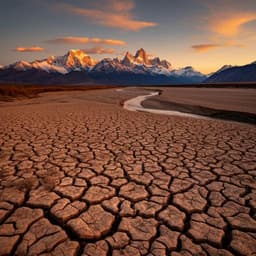
Earth Sciences
A coupled atmosphere-ocean source mechanism was a predictor of the 2022 Tonga volcanic tsunami
Y. T. Song, P. S. Callahan, et al.
This groundbreaking study by Y. Tony Song and colleagues reveals a novel source mechanism for tsunami generation linked to the 2022 Tonga volcanic eruption, where an atmospheric pressure wave accurately predicts tsunami behavior. Discover how this unique relationship between air-pressure dynamics and crater volume changes our understanding of volcanic tsunamis and enhances early warning systems.
~3 min • Beginner • English
Introduction
The Hunga-Tonga Hunga-Ha'apai (HTHH) volcano erupted on 15 January 2022, generating globally detectable atmospheric Lamb waves and a destructive near-field tsunami that devastated parts of Tonga. Classical volcanic-tsunami mechanisms (e.g., landslides, caldera collapse, deep-ocean explosions) do not readily explain the Tonga event because the pre-eruption edifice was partly subaerial with little overlying water, post-eruption surveys found no major caldera/flank collapse, and typical atmospheric pressure effects observed globally are only a few centimeters at the sea surface. The central research question is how the eruption produced a destructive near-field tsunami and what the physical linkage is between the co-occurring atmospheric pressure waves and the tsunami at the source. The study aims to determine whether a coupled atmosphere-ocean source mechanism governed by the eruption can explain observations and enable predictive capability for near-field warning.
Literature Review
Since Krakatau (1883), multiple volcanic tsunami generation mechanisms have been proposed, including subaerial/submarine landslides, pyroclastic flows, caldera/flank collapses, collapsing eruptive columns, deep-ocean explosions, volcano-tectonic earthquakes, and atmospheric pressure waves. Recent Tonga studies variously attributed the tsunami to atmospheric forcing via Proudman resonance, submarine explosions of prescribed megaton yields, or combinations of mechanisms with separately prescribed air-pressure and tsunami sources. Historical accounts recorded global Lamb waves and deadly tsunamis from Krakatau (1883) and fatalities from the 2018 Anak Krakatau event. Nineteen volcanic tsunami events have been recorded in the instrumental era. Despite this body of work, a unified source mechanism connecting air-pressure generation and tsunami formation at the source remained elusive due to limited near-field observations during eruptions.
Methodology
The authors developed an integrated atmosphere-ocean modeling framework using ROMS (Regional Ocean Modeling System) shallow-water equations with constant density, employing 12 vertical levels for the ocean (similar to prior 2004 and 2011 tsunami studies). The same ROMS core was used for the atmosphere by replacing water depth with an effective atmosphere depth derived from HA = γ R T / (M g), yielding ~11,189 m (γ=1.4, R=8314.36 J/kmol/K, T=273.15 K, M=28.966 kg/kmol). Air pressure anomalies were converted to equivalent water thickness via the inverse barometer (IB) relation (1 mbar ≈ 1 cm water). Initialization: Both components were initialized by depth-averaged velocity fields consistent with the eruption sequence but oriented oppositely—outward lateral blast in the atmosphere to represent rapid air expansion and inward influx in the ocean to represent water filling the erupted cavity. Three eruption cycles were imposed at 4:26, 5:01, and 5:46 UTC, each lasting 20 min (T=1200 s) with intensity halving each cycle, consistent with Tonga air-pressure data. Initial coefficients were tuned to observations: EA=0.05 and EO=0.17; a 50% addition during the early phase reproduced the observed head-and-shoulder air-pressure pattern. Model domain covered the Pacific with ~3 km grid, using ETOPO2 bathymetry. Progressive variables were surface elevation η and depth-averaged velocities (U,V) in atmosphere and ocean. The total sea-level anomaly (tsunami) was computed as ηT = ηA + ηO, where ηA is negative at the surface under positive air pressure due to IB. Energy diagnostics: Accumulated kinetic energy over three cycles was ~7.8×10^15 J (atmosphere) and ~3.5×10^14 J (ocean). A crater-based potential energy estimate used crater diameter 4 km and depth 0.8 km (volume ≈10 km^3), linking mass conservation to an estimated ~7 m sea-level depression over radius ~21.1 km by PE=½ρgAη and energy convertibility. Data inputs and validation: - Local and regional in situ observations: Tonga Meteorological Office air pressure; tide gauges at Nuku'alofa waterfront (nkfa) and Vuna Wharf (nkfa2). - DART bottom pressure records (converted to equivalent water thickness). - Satellite altimetry: SARAL/AltiKa (near-field, 29–38 min post-eruption), Sentinel-6 Michael Freilich (S6A), and Jason-3 (far-field, ~5 h post). Altimetry processing included cycle differencing (10-day repeat) for S6A/Jason-3 to isolate tsunami signals from mesoscale variability; AltiKa was on a drifting orbit so differencing was not applied. Predictive formulation: Air pressure p(t) was converted to a sea-level anomaly via IB and scaled to coastal runup using an empirical formula with a lead-time correction for differing propagation speeds: η(t+τ) = −pa(t)/(ρ g) Rt, τ = d/va − d/vo, Rt = 1.29 [tan(α)/(Ls/Hs)]^0.72 with case parameters Ls=40 km, Hs=1.2 m, α=3.6°. Propagation speeds used: air-pressure (Lamb) wave ≈330 m/s (atmospheric depth ~11.2 km); tsunami ≈82 m/s in near field (average depth ~680 m between HTHH and Tonga). Tonga is ~65 km from HTHH, yielding ~3 min arrival for air-pressure and ~13 min for tsunami (≈10 min lead).
Key Findings
- Coupled source mechanism: The eruption process simultaneously governs the air-pressure (Lamb) waves and the oceanic tsunami. Crater formation controls volcanic ejecta that drives air-pressure waves; corresponding ocean mass loss forces an inward water influx, generating the tsunami. - Predictive linkage: Converting air-pressure to sea-level via the IB effect and scaling with an empirical runup formula accurately predicted the first tsunami wave at Tonga, including amplitude and waveform; subsequent waves showed reduced agreement due to local resonance. - Lead times: Air-pressure waves precede tsunamis by distances-dependent intervals, enabling warning: ~5 min at 30 km, ~10 min at 65 km (Tonga), and ~50 min at 280 km (Suva, Fiji). - Threshold for destructive tsunamis: An air-pressure anomaly >15 mbar (hPa) at the coast indicates potential destructive near-field tsunamis, suggesting an actionable alarm criterion. - Propagation characteristics: Two tsunami types were distinguished in observations and model: atmospheric tsunami traveling at ~330 m/s and oceanic tsunami at depth-dependent speeds (far-field average ~160 m/s; near-field ~82 m/s towards Tonga). - Energetics and source geometry: Modeled source energies were ~7.8×10^15 J (atmosphere) and ~3.5×10^14 J (ocean). Observed crater dimensions (~4 km diameter, ~800 m depth; ~10 km^3 volume) are consistent with required water influx and estimated ~7 m local sea-level depression over ~21 km radius by energy/mass balance. - Multi-platform validation: The integrated model reproduced Tonga air-pressure and tide-gauge records (nkfa2; nkfa partially before malfunction at 5:25 UTC), DART bottom pressure waveforms and arrival times, and satellite altimetry detections (near-field by AltiKa at 29–38 min; far-field transects by S6A and Jason-3 ~5 h post-eruption). - Near- vs far-field impact: Satellite altimetry suggested the tsunami surface signal fell within typical ocean dynamic ranges in far-field regions, consistent with high destructiveness confined to the near field. - Event impacts: Near-field runup reached ~15 m at Mango Island with inundation up to ~500 m; overall damages estimated at US$90.4 M (~18.5% of Tonga GDP).
Discussion
The findings directly address how the HTHH eruption generated a destructive near-field tsunami with limited overlying water by revealing an eruption-driven, coupled atmosphere-ocean mechanism at the source. Rapid lateral air expansion (lateral blast) forms a low-pressure center and radiating Lamb waves, while mass removal into the atmosphere necessitates compensating ocean inflow, initiating the tsunami. The intrinsic mass-conservation linkage explains the observed temporal correlation between air-pressure troughs and tsunami amplitudes and provides a quantitative basis for prediction: fast-moving air-pressure waves act as reliable precursors to slower tsunamis. The model-data agreement across tide gauges, DART, and satellite altimetry strengthens the physical interpretation and clarifies why volcanic tsunamis tend to be most destructive near the source yet less impactful in the far field. This integrated view reconciles prior hypotheses by unifying atmospheric and oceanic contributions during source formation and underscores the practical value of air-pressure measurements for rapid, local warnings. The approach suggests reevaluating historical volcanic tsunami cases (e.g., Krakatau 1883, Anak Krakatau 2018) through the lens of coupled source physics and atmospheric precursors.
Conclusion
This study introduces and substantiates a coupled atmosphere-ocean source mechanism for volcanic tsunamis, wherein the eruption controls both Lamb-wave air-pressure signals and the oceanic tsunami via crater formation and mass redistribution. The work demonstrates that leading air-pressure waves quantitatively predict near-field tsunami timing and amplitude using simple IB conversion and an empirical runup scaling, offering actionable lead times of minutes to nearly an hour depending on distance. Multi-platform observations (tide gauges, DART, satellite altimetry) validate the mechanism and its predictive skill. Practically, the authors propose integrating inexpensive, widely maintained air-pressure sensors into tsunami early warning systems near tsunamigenic volcanoes, with indicative alarm thresholds (e.g., >15 mbar). Future work should expand sensor networks around ~90 potentially tsunamigenic volcanoes, refine thresholds and local runup calibrations, improve near-field resonance modeling, and reanalyze historical events within the coupled source framework.
Limitations
- Model simplifications: Depth-averaged shallow-water dynamics with constant density were used for both atmosphere and ocean, neglecting vertical structure, compressibility effects beyond effective depth, and complex multiphase eruptive flows. - Parameter calibration: Initial source coefficients (EA, EO) and the head-and-shoulder adjustment were tuned to match observations; predictive generalization may require site-specific calibration. - Empirical runup: Coastal runup was estimated using an empirical formula with chosen parameters (Ls=40 km, Hs=1.2 m, α=3.6°), which may not capture local coastal morphology and harbor resonance effects; later waves showed reduced predictability due to resonance. - Data constraints: The nkfa tide gauge malfunctioned after 5:25 UTC; near-field in situ observations during eruptions are inherently sparse. - Altimetry detection: Far-field altimetry required cycle differencing to separate tsunami from mesoscale variability; AltiKa’s drifting orbit limited differencing, and strong ocean dynamics (e.g., ACC eddies) complicated signal extraction. - Source complexity: While post-event surveys indicate no major caldera/flank collapse, smaller concurrent processes (e.g., minor slides, column collapse) cannot be fully excluded and are not explicitly isolated. - Generalizability: Thresholds such as the 15 mbar alarm level are based on this event and nearby observations; broader validation across different volcanoes and bathymetric settings is needed.
Related Publications
Explore these studies to deepen your understanding of the subject.







